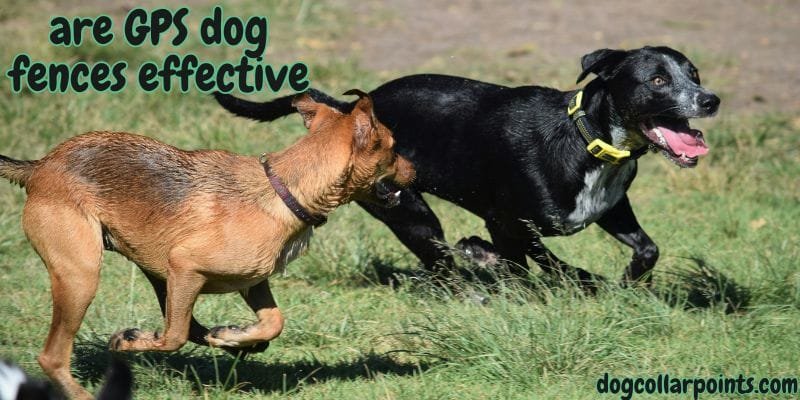Are GPS Dog Fences Effective and Secure?

For every dog owner, the safety and well-being of their beloved furry friend is paramount. That’s why dog containment systems are an essential consideration for pet owners. Traditionally, this has meant physical barriers, such as wooden or chain-link fences, to keep dogs within their designated areas. However, innovation in the pet tech industry has introduced a new solution to the challenge of dog containment — GPS dog fences.
In this comprehensive guide, we’ll explore the concept of GPS dog fences, how they operate, and, most importantly, their effectiveness in safeguarding your dog. By the end, you’ll have a clearer picture of whether GPS dog fences are the right choice for your four-legged family member.
The Concept of GPS Dog Fences
GPS dog fences, also known as wireless dog fences, leverage GPS technology to define a virtual boundary for your dog without the need for physical barriers. They offer a flexible and customisable way to establish ‘safe zones’ for your pet, allowing them the freedom to roam within set parameters while keeping them out of unsafe areas.
These systems typically consist of a transmitter, through which pet owners can mark the boundaries, and a receiver collar worn by the dog. Dogs are deterred from approaching boundaries when their collars emit warning sounds or vibrations. If the dog continues to the edge of the designated area, the collar administers a mild static correction, similar to the sensation of a TENS machine used for muscle therapy.
How Does a GPS Dog Fences Work?
Modern GPS dog fences are more than just systems that keep your dog within a specific geographical location. They provide a multi-tiered approach to boundary control:
Setting Boundaries
The owner marks the boundaries of the property using a handheld device or a smartphone app. This could include the edges of a yard, a garden, or even the perimeter of a campsite.
Correction Mechanism
When the dog breaches the established boundary, the collar delivers a corrective signal, prompting the dog to retreat to the safe zone. The intensity of the static correction is adjustable, ensuring it’s appropriate for the dog’s size and temperament.
Training Mode
Most GPS dog fence systems include a training mode, where correctional behavior is introduced gradually. This training is crucial for acclimatising the dog to the fence and ensuring they understand the associated warnings.
Real-Time Tracking
Some advanced GPS systems offer tracking capabilities, allowing you to locate your dog in real-time, should they manage to cross the boundary. This is particularly useful in large properties or during outdoor excursions.
How Effective are GPS Dog Fences?
The effectiveness of GPS dog fences will depend on several factors, including the breed and individual behaviour of your dog, the training you provide, and the specific product you choose.
Training is Key
No containment system, whether physical or virtual, can keep your dog safe without proper training. It takes the same amount of time and effort to train your dog to respect the boundaries of a GPS dog fence. Most dogs can learn these boundaries relatively quickly with consistent and positive reinforcement.
Individual Dog Behavior
The temperament and previous experiences of your dog play a significant role in the fence’s effectiveness. High-energy breeds or those with strong prey drives may initially be more challenging to contain. However, with patience and proper training, even the most adventurous dogs can learn to stay within the virtual fence lines.
System Calibration
Choosing a reputable brand and correctly calibrating the GPS system is essential for its function. Poorly calibrated systems can give false boundary warnings or fail to correct the dog at the appropriate distance from the edge.
Weather and Environment
Environmental factors, such as dense foliage or hilly terrain, can affect the performance of the GPS signal. It’s important to consider the local weather and landscape when deciding if a GPS fence is right for your property.
Pros of GPS Dog Fences
There are several advantages to choosing a GPS dog fence over a conventional one:
Portability and Flexibility
A significant advantage of GPS dog fences is their portability. If you move homes or simply want to change the dog’s boundaries, it’s as easy as reprogramming the system. This makes GPS dog fences a flexible option for dog owners.
No Physical Barriers
Some dogs may find ways to escape from or attempt to climb over traditional fences. A GPS dog fence provides a barrier that’s invisible and intangible, eliminating the physical obstacle to your dog’s natural behaviour.
Safety and Freedom
With a GPS dog fence, you can offer your dog a safe space to explore without the risk of them roaming into roads or unknown territory. This freedom can be incredibly beneficial to a dog’s mental and physical well-being.
Personalisation
GPS dog fences allow you to customise the boundary according to your needs, something not possible with standard fencing. This might include leaving open sections to certain areas, practical for entrances, or designating separate areas for multiple pets.
Cons of GPS Dog Fences
Despite their advantages, GPS dog fences also come with some drawbacks:
Initial Investment
Compared to the one-time cost of a physical fence, GPS dog fences often have a higher initial investment. However, when you consider that physical fences may require maintenance, repair, and replacement, the cost balance might shift over time.
Training Required
Effective training is essential, and the responsibility falls on the pet owner. This can be time-consuming, especially if the dog is particularly resistant or has challenging behaviour.
Weaknesses in Functionality
GPS signals aren’t infallible, and there could be instances where the system fails to correct or locate your dog accurately. This could be due to environmental conditions, battery life, or other technical issues.
Lack of Containment
Unlike physical fences, which can keep other animals out, GPS dog fences only serve the purpose of containing your dog. This can be a disadvantage if you’re also concerned about wildlife or other dogs entering your property.
Conclusion | Are GPS Dog Fences Effective
GPS dog fences are a valuable tool for pet owners looking to give their dog the freedom to roam without the inherent risks. When properly deployed and used, they can be highly effective in training and containing most dogs. However, they are not a one-size-fits-all solution, and considerations must be made for your dog’s characteristics and the environment in which the fence will be used.
Before making a decision, it’s essential to research products, read reviews, and, if possible, consult with a veterinarian or animal behaviourist. With the right approach, a GPS dog fence can be a step towards ensuring the safety and happiness of your canine companion.
Frequently Asked Questions (FAQs)
1. Do GPS dog fences effectively contain dogs?
GPS dog fences can be effective in containing most dogs with proper training and calibration. However, individual dog behavior and environmental factors may also play a role in their effectiveness.
2. How accurate are SpotOn GPS fences for dogs?
SpotOn GPS fences have been reported to be highly accurate, with real-time updates and precise boundary corrections. However, factors such as terrain and weather can affect their accuracy.
3. Are virtual dog fences an effective alternative to physical fences?
Virtual dog fences can be a useful alternative for pet owners who prefer not to install physical barriers or have restrictions on traditional fencing options. However, they require proper training and may not be suitable for all dogs.
4. Can a dog break through an invisible fence?
Invisible fences, such as GPS dog fences, rely on training and positive reinforcement to contain dogs. However, some determined or stubborn dogs may still attempt to run or jump over the boundaries if not adequately trained.






